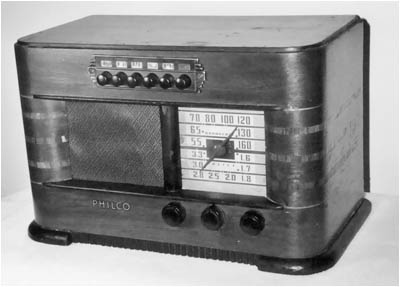Of Old Radios And Related Items--Published Monthly
Push-Button Tuning and the Philco 41-225
BY RICHARD ARNOLD
WEB EDITION
Push-button controls became a big selling point for radio salesmen of the 1930s. Here Richard Arnold talks about a favorite set in his collection which still has working push buttons. (Editor)
An article in Radio News magazine for December 1937 tells about the latest trends in "touch tuning" or push-button control systems for the year 1938. The article starts out saying, "push-button station selection gives the ultimate in convenience and simplicity of tuning to the owner of a 1938 model receiver. These advantages are so immediately evident that radio dealers and servicemen consider this feature the most forceful selling point offered in recent years.
"The vast improvement in the performance of present-day push-button tuning over the expensive, complicated systems in vogue years ago is due in considerable measure to other developments in receiver design that bear no direct relationship to push-button tuning. In particular, automatic frequency control and high frequency, broadband IF transformers overcome the mechanical difficulties of hair-line tuning which caused designers of push-button systems so much distress in years gone by, while modern oscillator circuits have a degree of frequency stability not hitherto realized.
The new systems show ruggedness in design and construction, which promise long trouble-free operation. Their freedom from delicate relays with light spring contacts eliminates a source of trouble found in earlier models."
There were many different systems of push-button tuning available in 1938 and subsequent years. General Electric had one that operated by a special 6-volt reversing-type motor. RCA had one where the motor was mounted on top of the variable condenser gang. Other companies like Knight (Allied Radio Company) and Lafayette, just to name a few, had their own systems.
The Philco Model 41-225
The 1941 Philco Model 41-225, shown above, is a good example of the push-button sets popular in this period. This model has electric push-button tuning in addition to manual tuning and two tuning ranges. The electric push-button mechanism consists of six push buttons. One push button is used to turn the power off and on, and the remaining five to tune for the automatic tuning of broadcasting stations.
The 1941 Philco 41-225 is a 6-tube, AC/DC superhet that uses one each of the following tube types: a 7C7 RF; a 7A8 detector and oscillator; a 7B7 IF; a 7C6 2nd detector, AVC, and 1st audio; a 35A5 output; and a 35Z3 rectifier. The 35Z3 is a half-wave, high vacuum rectifier, while the 35A5 is a power beam amplifier. The 7C7s, the 7A8, and the 7C6 have 6.3-volt filaments; the 35Z3 and 35A5 have 35-volt filaments. The radio uses a single 6-8v bayonet type dial lamp.
This Philco Model 41-225 is a 6-tube, AC/DC radio that tunes from 550 kHz to 3.3 MHz in two ranges. It features push-button tuning on the BC band.The radio tunes the broadcast band from 540-1600 Kc and a shortwave band of 1.6 to 3.3 Mc. It uses an airplane dial pointer with a red plastic pointer. Of the three original knobs on the radio, the first one on the left is the volume control. The center knob has three positions: one for activating the push buttons, the other two for the broadcast and police bands. The third knob is for station selection. The grille cloth is not original.
Rider says that this model was introduced prior to April 1941. Ron Ramirez, in his book Philco Radio 1928-1942, has described it as "somewhat hard to find."
I think that the radio has a nice design and seems to be quite popular. Watching for these sets on eBay, I find that when they do show up -- which is not very often -- they are selling for between $67 and $75.
The radio plays really well, and the push buttons still work after all these years. I guess the promise that was made for the push buttons to have "a long, trouble-free operational life" was true. This very interesting radio has become a part of my collection, and the hunt goes on.
References:
Rider, John F. Perpetual Troubleshooters Manual. Vol. 12, p. 48.
Radio News, December 1937, pp. 330-331
Ramirez, Ron with Michael Prosise. Philco Radio 1928-1942. Atglen, PA: Schiffer Publishing, 1993.
(Richard Arnold, P.O. Box 275, Lone Grove, OK 73443. arnold@brightok.net)
Richard Arnold, a frequent contributor to A.R.C., has been collecting since 1985. His interest is primarily in cathedrals and 1920s battery sets, and his collection ranges from crystal sets to a 1928 Bosch in a Pooley cabinet. His prize is the 1932 Jackson Bell Peter Pan featured in the June 1991 A.R.C.
| [Free Sample] [Books, etc., For Sale] [Subscribe to A.R.C./Renew] [Classified Ads] [Auction Prices] [Event Calendar] [Links] [Home] [Issue Archives] [Book Reviews] [Subscription Information] [A.R.C. FAQ] URL = http://www.antiqueradio.com/Sep05_Arnold_Philco.html Copyright © 1996-2005 by John V. Terrey - For personal use only. Last revised: August 27, 2005. For Customer Assistance please contact ARC@antiqueradio.com or call (866) 371-0512 toll free Pages designed/maintained by Wayward Fluffy Publications
Antique Radio Classified |
